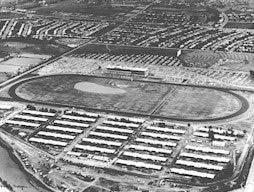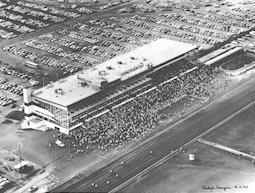Centennial Race Track
When Centennial Race Track opened for horse racing on July 4, 1950, its owners dubbed it the Santa Anita of the Rockies, seeking a favorable comparison with the famous California track. One local newspaperman re-dubbed it the Santa Anna of the Rockies, drawing a less favorable comparison with the defeated Mexican dictator. "It was born under a cloud and it never really seemed to recover," quipped Rocky Mountain News sports editor Chet Nelson when it closed in 1983.
Colorado voters had approved the Parimutuel Act of 1948, and potential investors were soon standing in line. The first group to be granted a charter by the Colorado Racing Commission were backers of Mile High Kennel Club in Commerce City, which opened its doors in 1949. Others soon received their charter to build Colorful Downs near Littleton. Before construction was completed, the owners thought better of the cute play on words and, wanting a classier image, chose Centennial Turf Club.
Nearly 10,000 people passed through the gates during the Independence Day opening, wagering a half a million dollars. General Manager Willard Tunney confidently predicted that the average daily income would be $400,000. Reality fell far short of this, with the 46 racing dates of the 1950 season averaging a mere $50,000. This was $30,000 less per day than Mile High Kennel Club.
Competition with Mile High was most often cited as the main reason for Centennial's eventual demise. Some of this they brought on themselves, as it "cost $10 [in parking and admission] to get to your seat" at Centennial. To view the dogs, Mile High provided free parking and a 25-cent admission. Centennial was "too plush" according to some customers and there was less waiting time between races at Mile High, and more races in an evening.
But there were other problems as well. Soon after their charter was granted, it was revealed that President M.M. Mitchell of Centennial and Chairman John Monaghan of the Racing Commission were partners in horse ownership in other states. Though both men resigned and were later exonerated by an investigation, this created the cloud Nelson referred to. Early management couldn't decide on a cohesive operation and promotion plan, and constantly changing race dates put the public in a quandary. Most of the time it seemed that finances were short, but when solid ownership arrived in 1968 in the person of the Jacobs Brothers of Buffalo, NY, their reputed ties to the "mob" caused continued scrutiny.


Centennial Race Track, 1972.
Basically, though, it came down to the quality of horseflesh the owners put on the track, which started out suspect and continued a downward spiral. Geographic isolation was one problem. Eastern breeders would not come this far, except to fly to California. California breeders only went to the "Triple Crown" and again, by plane. Agreements with tracks in Arizona and Kansas brought some good horses to Denver, but it could not be sustained. Only one horse based at Centennial ever raced at the Kentucky Derby. Phil D finished fourth in 1951 after leading early. Unfortunately, the quality peaked in only the second year of a 33 year run.
The owners occasionally would bring in top jockeys like Willie Shoemaker and Bill Hartack for a few rides to boost interest. The 1965 Platte River flood killed a hundred horses and was expected to close the track, but the resourcefulness of GM Ivan Thomas opened the season in a month, only four days late. During the 1970s the track tried numerous gimmicks to hang on: night racing, harness racing, "future" wagering, and in 1981 it was the first track in the nation to offer wagering on another track. Twelve thousand showed up on Kentucky Derby Day that year to watch that race on closed-circuit television and wager nearly $1 million. The annual Muscular Dystrophy Association Media Races featured the only races between humans that could be bet on legally in the U.S. None of this could close the gap with Mile High, which consistently, year after year, drew three times as many fans and twice the profits per day.
In 1981, the property was sold to the Talley Corporation and Denver developer Kenneth Good for $17.7 million -- more than one hundred times the original $160,000 purchase of Hazard Ranch in 1949. Racing continued only for as long as it took to get the building permits for an apartment, condo and office complex. The last of some 23,000 races was run on November 6, 1983 and construction began shortly thereafter on residential housing. Today the area includes over 500 homes which are part of the Riverwalk Community.
Bibliography
Littleton Independent. Littleton Independent Publishers, 1888- .
Littleton Museum. Photographic Archives.
____. Vertical File: "Centennial Race Track".
McQuarie, Robert J. and C.W. Buchholtz. Littleton, Colorado: Settlement to Centennial. Littleton: Littleton Historical Museum and Friends of the Library and Museum, 1990.
Rocky Mountain News. Denver: Rocky Mountain News Publishers, 1861- .
Photographs courtesy of the Littleton Museum unless otherwise noted. To order copies, contact the museum at 303-795-3950.
Compiled by Pat Massengill
Updated April 2021 by Phyllis Larison